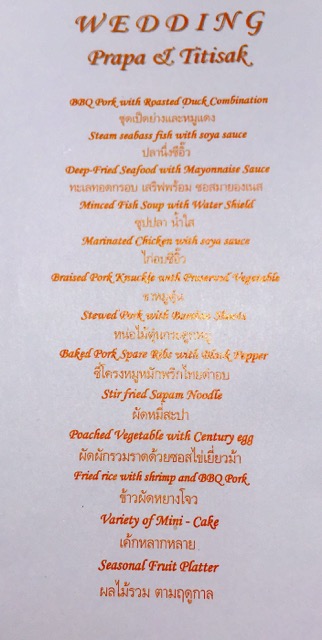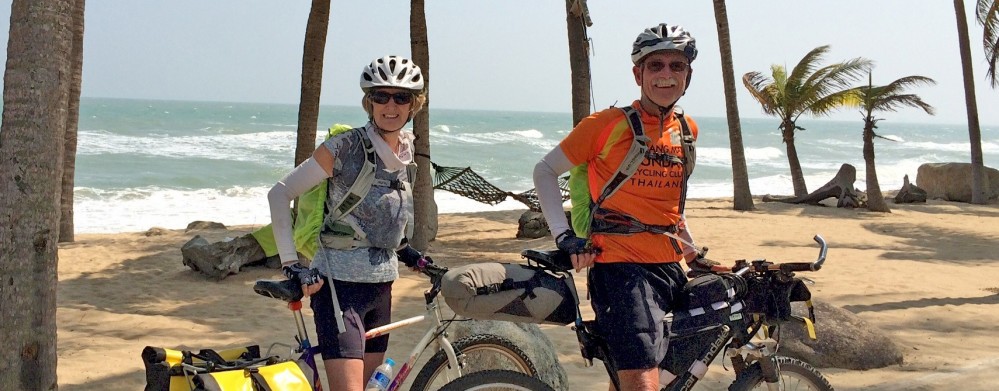 There must be several hundred bicycles to rent in Nyaungshwe, most of them Chinese cruiser bikes with a tractor saddle and a basket up front. The going rate is $1.50 a day, and the most recommended tour, besides riding around town, is to go west to the hot springs. As it was Sunday when we decided to ride, we figured the Hot Springs might be more crowed than usual, if not primarily with foreigners, which we were seeing too many all ready. We had seen a couple of mountain bikes advertised and happen to run across the back street house on our wandering several days earlier, so we opted for the high priced models at $10 a day.
There must be several hundred bicycles to rent in Nyaungshwe, most of them Chinese cruiser bikes with a tractor saddle and a basket up front. The going rate is $1.50 a day, and the most recommended tour, besides riding around town, is to go west to the hot springs. As it was Sunday when we decided to ride, we figured the Hot Springs might be more crowed than usual, if not primarily with foreigners, which we were seeing too many all ready. We had seen a couple of mountain bikes advertised and happen to run across the back street house on our wandering several days earlier, so we opted for the high priced models at $10 a day.
 Our route was to go east around the lake and see how far we got and since it was and all day adventure having gears and an adjustable seat post seems like a priority. As it was we rode about 70 km down and back on one side of the lake, and after about the first 4 k’s we virtually had the road to ourselves.
Our route was to go east around the lake and see how far we got and since it was and all day adventure having gears and an adjustable seat post seems like a priority. As it was we rode about 70 km down and back on one side of the lake, and after about the first 4 k’s we virtually had the road to ourselves.

Everything to the east of the lake was agricultural and primarily cane in the dry hills and rice and vegetables down in he low lands at lake level.
One thing that we didn’t appreciate in all of Myanmar is the smoke filled air. In Yangon is was very bad and up north with the dry season just starting all the farmers are burning whatever has dried out.
 Add to the agricultural waste, the proliferation of wood stoves, sugar cane plants – large and small – the skies continually smoke filled unless there was a strong wind. Never-the-less it was really interesting to see all the country folk going about tending their fields, hauling cane on ox carts to the processing plants. We even saw a volley ball net strung above a field of drying cane husks.
Add to the agricultural waste, the proliferation of wood stoves, sugar cane plants – large and small – the skies continually smoke filled unless there was a strong wind. Never-the-less it was really interesting to see all the country folk going about tending their fields, hauling cane on ox carts to the processing plants. We even saw a volley ball net strung above a field of drying cane husks.

The net is barely visible in the photo to the left, and we later learned that one of the national sports is a form of whiffle-ball-type volley ball played with feet, knees and heads called chinlone. In Thailand they use a hanging basket 6 meters in the air and try and put a tradition soccerball high up into the net like a hack-sack game played with feet, knees and heads.
 One of the most remarkable things was seeing a “chip-and-seal” crew enlarging and resurfacing the single paved road. After digging up the shoulder and place a meter-wide
One of the most remarkable things was seeing a “chip-and-seal” crew enlarging and resurfacing the single paved road. After digging up the shoulder and place a meter-wide  of papaya-sized stones in they come back with a single layer of golfball-sized stones that are laid in place by eight girls with rubber trays of the stones (12 to 15 stones at a time). Once the smaller stones are in place a steamroller crushes them to the size of pea gravel and then two team of two boys carry hot oil from a roadside trench and ladel over the crushed stones between steamroller trips. The finished product looks very similar to our more high tech less labor intensive methods. When there are no minimum wage levels like Myanmar the day labor rate hovers just above $2 a day and that why all the projects seem to be done by hand.
of papaya-sized stones in they come back with a single layer of golfball-sized stones that are laid in place by eight girls with rubber trays of the stones (12 to 15 stones at a time). Once the smaller stones are in place a steamroller crushes them to the size of pea gravel and then two team of two boys carry hot oil from a roadside trench and ladel over the crushed stones between steamroller trips. The finished product looks very similar to our more high tech less labor intensive methods. When there are no minimum wage levels like Myanmar the day labor rate hovers just above $2 a day and that why all the projects seem to be done by hand.
 Quite accidentally we stumbled upon the break-down of the rotating 5-day market that sets up in the five alternating lake-side communities. An entire market place is transported each day to the various appointed site. Most items are shuffled from boat to market stall in baskets suspended on bamboo poles. We’re numb when it comes to looking at market
Quite accidentally we stumbled upon the break-down of the rotating 5-day market that sets up in the five alternating lake-side communities. An entire market place is transported each day to the various appointed site. Most items are shuffled from boat to market stall in baskets suspended on bamboo poles. We’re numb when it comes to looking at market  stalls except when it’s fresh foods. It was with particular interest that we got to see them decamping entire market place into a hundred longtail boats. It puts into perspective how th Swiss lords travelled daily between their castles. With enough people you can move an enormous amount of goods from cart to castle or in this case boat to market. I guess the closest thing we have to this phenomena is flea markets or closer to our life river rafting.
stalls except when it’s fresh foods. It was with particular interest that we got to see them decamping entire market place into a hundred longtail boats. It puts into perspective how th Swiss lords travelled daily between their castles. With enough people you can move an enormous amount of goods from cart to castle or in this case boat to market. I guess the closest thing we have to this phenomena is flea markets or closer to our life river rafting.

Lunch in one of the remaining open restaurants was surprising in two aspects first they had a bilingual menu (Burmese and English ) with no prices so I suspect price varies on the clientele and second the servings were labourer-sized with soup side dish of fresh tomatoes. On the way home we stopped for a beverage and were severed complimentary oranges.

We definitely travelled back a ways in time when we got off the beaten path. with ox carts, kids rolling dead motor cycle tires with a stick, and road gangs of young women. We managed the entire day without seeing and foreigners until we got close to town.
By the way, all those new Bianchi’s came across the boarder from Thailand and were very sweet rides. I checked out the Thai price once I got home and they can be had for $400 in Trang.
 About 12 members cycled the 25 miles to the wedding and attended in full lycra garb. We chose to drive the scooter over, like many, and stay less sweaty for the party. The venue was idyllic and right out of the Thailand tourist resort brochures with pools, white sand beach location and all the amenities tourists clamor for. If we hadn’t been recently to Myanmar this would have been the most “white” people we’d been around on our travels this year. Total beach bikini scene right out of the movies. We couldn’t wait to get home and see what tariff was for nightly stays ($200 to $600). Makes our $6 a night seem paltry.
About 12 members cycled the 25 miles to the wedding and attended in full lycra garb. We chose to drive the scooter over, like many, and stay less sweaty for the party. The venue was idyllic and right out of the Thailand tourist resort brochures with pools, white sand beach location and all the amenities tourists clamor for. If we hadn’t been recently to Myanmar this would have been the most “white” people we’d been around on our travels this year. Total beach bikini scene right out of the movies. We couldn’t wait to get home and see what tariff was for nightly stays ($200 to $600). Makes our $6 a night seem paltry. This couple have been boyfriend and girlfriend for 21 years and finally decided to get married. He’s a distance cyclist who will be riding in the Audax 1200 Paris-Brest-Paris ride this September. He’s completed his 200, 300, 400 and 600 km rides here in Thailand and now qualifies for the 1200 km.
This couple have been boyfriend and girlfriend for 21 years and finally decided to get married. He’s a distance cyclist who will be riding in the Audax 1200 Paris-Brest-Paris ride this September. He’s completed his 200, 300, 400 and 600 km rides here in Thailand and now qualifies for the 1200 km. Only family and very close friends attend the early morning wedding ceremony at their house (monk drops by to consecrate the union) and then they throw a big reception at a hall or resort. This reception was a sit-down 11-course meal, served on a meter-wide lazy-susan placed in the center of 8′ circular banquet tables,
Only family and very close friends attend the early morning wedding ceremony at their house (monk drops by to consecrate the union) and then they throw a big reception at a hall or resort. This reception was a sit-down 11-course meal, served on a meter-wide lazy-susan placed in the center of 8′ circular banquet tables,  that takes much of the afternoon. We had a great time with our rowdy cycling friends.
that takes much of the afternoon. We had a great time with our rowdy cycling friends.















 traditional dance being performed at a hilltop shrine. As is common on most “passes” (high points) on mountain roads the Thai people erect elaborate shrines to Buddha. It’s mandatory to honk when passing and some people stop to leave “tribute” in the form of flower wreathes, soda pop with a straw, burn an incense stick or light a reel of firecrackers.
traditional dance being performed at a hilltop shrine. As is common on most “passes” (high points) on mountain roads the Thai people erect elaborate shrines to Buddha. It’s mandatory to honk when passing and some people stop to leave “tribute” in the form of flower wreathes, soda pop with a straw, burn an incense stick or light a reel of firecrackers.








































